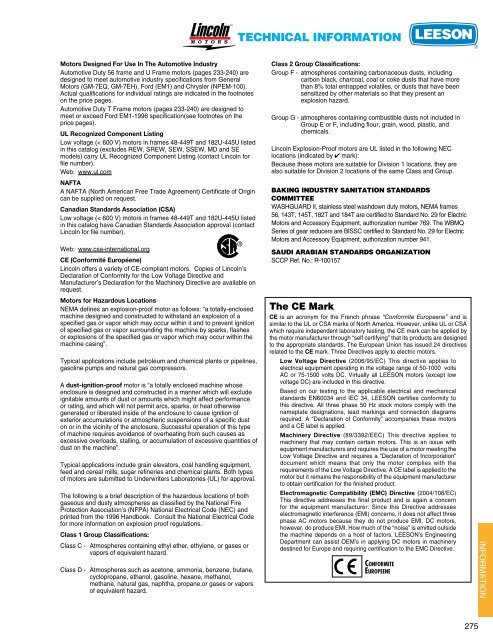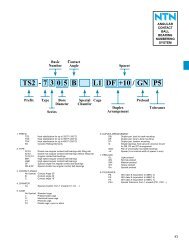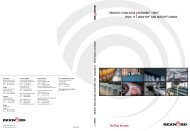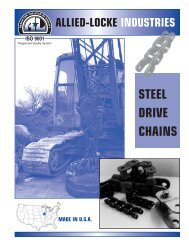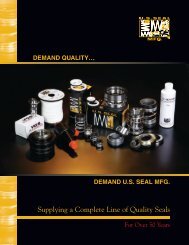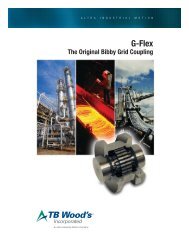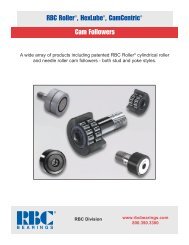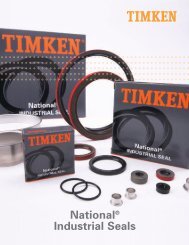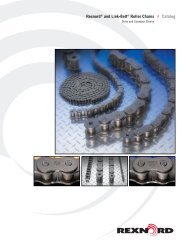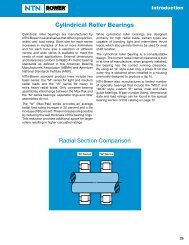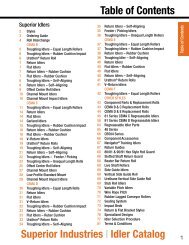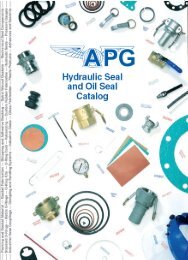LEESON / LINCOLN Motor Catalog - Norfolkbearings.com
LEESON / LINCOLN Motor Catalog - Norfolkbearings.com
LEESON / LINCOLN Motor Catalog - Norfolkbearings.com
Create successful ePaper yourself
Turn your PDF publications into a flip-book with our unique Google optimized e-Paper software.
TECHNICAL INFORMATION<br />
<strong>Motor</strong>s Designed For Use In The Automotive Industry<br />
Automotive Duty 56 frame and U Frame motors (pages 233-240) are<br />
designed to meet automotive industry specifications from General<br />
<strong>Motor</strong>s (GM-7EQ, GM-7EH), Ford (EM1) and Chrysler (NPEM-100).<br />
Actual qualifications for individual ratings are indicated in the footnotes<br />
on the price pages.<br />
Automotive Duty T Frame motors (pages 233-240) are designed to<br />
meet or exceed Ford EM1-1996 specification(see footnotes on the<br />
price pages).<br />
UL Recognized Component Listing<br />
Low voltage (< 600 V) motors in frames 48-449T and 182U-445U listed<br />
in this catalog (excludes REW, SREW, SEW, SSEW, MD and SE<br />
models) carry UL Recognized Component Listing (contact Lincoln for<br />
file number).<br />
Web: www.ul.<strong>com</strong><br />
NAFTA<br />
A NAFTA (North American Free Trade Agreement) Certificate of Origin<br />
can be supplied on request.<br />
Canadian Standards Association (CSA)<br />
Low voltage (< 600 V) motors in frames 48-449T and 182U-445U listed<br />
in this catalog have Canadian Standards Association approval (contact<br />
Lincoln for file number).<br />
Web: www.csa-international.org<br />
CE (Conformité Européene)<br />
Lincoln offers a variety of CE-<strong>com</strong>pliant motors. Copies of Lincoln’s<br />
Declaration of Conformity for the Low Voltage Directive and<br />
Manufacturer’s Declaration for the Machinery Directive are available on<br />
request.<br />
<strong>Motor</strong>s for Hazardous Locations<br />
NEMA defines an explosion-proof motor as follows: “a totally-enclosed<br />
machine designed and constructed to withstand an explosion of a<br />
specified gas or vapor which may occur within it and to prevent ignition<br />
of specified gas or vapor surrounding the machine by sparks, flashes<br />
or explosions of the specified gas or vapor which may occur within the<br />
machine casing”.<br />
Typical applications include petroleum and chemical plants or pipelines,<br />
gasoline pumps and natural gas <strong>com</strong>pressors.<br />
A dust-ignition-proof motor is “a totally enclosed machine whose<br />
enclosure is designed and constructed in a manner which will exclude<br />
ignitable amounts of dust or amounts which might affect performance<br />
or rating, and which will not permit arcs, sparks, or heat otherwise<br />
generated or liberated inside of the enclosure to cause ignition of<br />
exterior accumulations or atmospheric suspensions of a specific dust<br />
on or in the vicinity of the enclosure. Successful operation of this type<br />
of machine requires avoidance of overheating from such causes as<br />
excessive overloads, stalling, or accumulation of excessive quantities of<br />
dust on the machine”.<br />
Typical applications include grain elevators, coal handling equipment,<br />
feed and cereal mills, sugar refineries and chemical plants. Both types<br />
of motors are submitted to Underwriters Laboratories (UL) for approval.<br />
The following is a brief description of the hazardous locations of both<br />
gaseous and dusty atmospheres as classified by the National Fire<br />
Protection Association’s (NFPA) National Electrical Code (NEC) and<br />
printed from the 1996 Handbook. Consult the National Electrical Code<br />
for more information on explosion proof regulations.<br />
Class 1 Group Classifications:<br />
Class C - Atmospheres containing ethyl ether, ethylene, or gases or<br />
vapors of equivalent hazard.<br />
Class D - Atmospheres such as acetone, ammonia, benzene, butane,<br />
cyclopropane, ethanol, gasoline, hexane, methanol,<br />
methane, natural gas, naphtha, propane,or gases or vapors<br />
of equivalent hazard.<br />
Class 2 Group Classifications:<br />
Group F - atmospheres containing carbonaceous dusts, including<br />
carbon black, charcoal, coal or coke dusts that have more<br />
than 8% total entrapped volatiles, or dusts that have been<br />
sensitized by other materials so that they present an<br />
explosion hazard.<br />
Group G - atmospheres containing <strong>com</strong>bustible dusts not included in<br />
Group E or F, including flour, grain, wood, plastic, and<br />
chemicals.<br />
Lincoln Explosion-Proof motors are UL listed in the following NEC<br />
locations (indicated by 4 mark):<br />
Because these motors are suitable for Division 1 locations, they are<br />
also suitable for Division 2 locations of the same Class and Group.<br />
BAKING INDUSTRY SANITATION STANDARDS<br />
COMMITTEE<br />
WASHGUARD II, stainless steel washdown duty motors, NEMA frames<br />
56, 143T, 145T, 182T and 184T are certified to Standard No. 29 for Electric<br />
<strong>Motor</strong>s and Accessory Equipment, authorization number 769. The WBMQ<br />
Series of gear reducers are BISSC certified to Standard No. 29 for Electric<br />
<strong>Motor</strong>s and Accessory Equipment, authorization number 941.<br />
SAUDI ARABIAN STANDARDS ORGANIZATION<br />
SCCP Ref. No.: R-100157<br />
The CE Mark<br />
CE is an acronym for the French phrase “Conformite Europeene” and is<br />
similar to the UL or CSA marks of North America. However, unlike UL or CSA<br />
which require independent laboratory testing, the CE mark can be applied by<br />
the motor manufacturer through “self certifying” that its products are designed<br />
to the appropriate standards. The European Union has issued 24 directives<br />
related to the CE mark. Three Directives apply to electric motors.<br />
Low Voltage Directive (2006/95/EC) This directive applies to<br />
electrical equipment operating in the voltage range of 50-1000 volts<br />
AC or 75-1500 volts DC. Virtually all <strong>LEESON</strong> motors (except low<br />
voltage DC) are included in this directive.<br />
Based on our testing to the applicable electrical and mechanical<br />
standards EN60034 and IEC 34, <strong>LEESON</strong> certifies conformity to<br />
this directive. All three phase 50 Hz stock motors <strong>com</strong>ply with the<br />
nameplate designations, lead markings and connection diagrams<br />
required. A “Declaration of Conformity” ac<strong>com</strong>panies these motors<br />
and a CE label is applied.<br />
Machinery Directive (89/3392/EEC) This directive applies to<br />
machinery that may contain certain motors. This is an issue with<br />
equipment manufacturers and requires the use of a motor meeting the<br />
Low Voltage Directive and requires a “Declaration of Incorporation”<br />
document which means that only the motor <strong>com</strong>plies with the<br />
requirements of the Low Voltage Directive. A CE label is applied to the<br />
motor but it remains the responsibility of the equipment manufacturer<br />
to obtain certification for the finished product.<br />
Electromagnetic Compatibility (EMC) Directive (2004/108/EC)<br />
This directive addresses the final product and is again a concern<br />
for the equipment manufacturer. Since this Directive addresses<br />
electromagnetic interference (EMI) concerns, it does not affect three<br />
phase AC motors because they do not produce EMI. DC motors,<br />
however, do produce EMI. How much of the “noise” is emitted outside<br />
the machine depends on a host of factors. <strong>LEESON</strong>’s Engineering<br />
Department can assist OEM’s in applying DC motors in machinery<br />
destined for Europe and requiring certification to the EMC Directive.<br />
Conformite<br />
Europeene<br />
INFORMATION<br />
275


